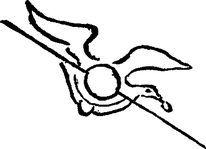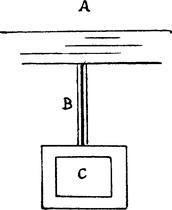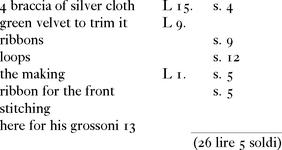Notebooks (52 page)
Authors: Leonardo da Vinci,Irma Anne Richter,Thereza Wells
Tags: #History, #Fiction, #General, #European, #Art, #Renaissance, #Leonardo;, #Leonardo, #da Vinci;, #1452-1519, #Individual artists, #Art Monographs, #Drawing By Individual Artists, #Notebooks; sketchbooks; etc, #Individual Artist, #History - Renaissance, #Renaissance art, #Individual Painters - Renaissance, #Drawing & drawings, #Drawing, #Techniques - Drawing, #Individual Artists - General, #Individual artists; art monographs, #Art & Art Instruction, #Techniques

Open your eyes and look carefully that your money is not so spent as to purchase your own shame. I can assure you that from this district you will get nothing but average works of inferior and coarse masters. There is not a man who is capable—and you may believe me—except Leonardo the Florentine who is making the bronze horse of the Duke Francesco and who has no need to bring himself into notice, because he has work to do which will last him the whole of his life, and I doubt whether he will ever finish it, so great it is.
The miserable students . . . with what hope may they expect a reward. Here is one whom his Lordship has invited from Florence to do this work and he is a capable master, but he has so much, oh! so much, to do that he will never finish it. And what do you imagine is the difference between seeing a beautiful object and an ugly one? Quote Pliny.
57
57
The following notes accompany the drawing of a machine for sharpening needles, with an ingenious system of gears, travelling belts, and an emery wheel, possibly the first mass-production machine in history.
Tomorrow morning on the second day of January 1496 I shall have the strap made and make the test.
100 times an hour and 400 needles every time. That means 40,000 needles per hour, and 480,000 in twelve hours. Let us say 4,000,000 would bring in 20,000 soldi at 5 soldi per 1,000. That is a total of 1,000 Lire for every working day and with twenty working days every month it would be 60,000 Ducats a year.
58
58
On 31 January 1496 at the house of Conte di Cajazzo in the presence of the duke and the people of Milan was performed a play on Danae composed by Baldassare Taccone for which Leonardo designed the stage scenery. A sheet with sketches and a list of dramatis personae is at the Metropolitan Museum, New York.

Announcer of the performance.
Those who marvel at the new star and kneel and worship it and kneeling down with music close the performance.
A costume for carnival
To make a beautiful costume take a supple cloth and give it an odoriferous varnish made of oil of turpentine and of varnish; ingrain and glue with a pierced stencil, which must be wetted, that it may not stick to the cloth; and this stencil may be made in a pattern of knots which afterwards may be filled in with black and the ground with white millet.
59
59
A bird for a comedy.
60
60

Leonardo was at this time occupied with the water supply to the Castello Sforzesco.
Key of the bath of the Duchess.
Show all the ways of unlocking and releasing. Put them together in their chapter. [
With drawing
.]
61
With drawing
.]
61
To warm the water of the stove of the Duchess add three parts of warm water to four parts of cold water.
62
62
A way of flooding the castle [
with a plan of the Castello Sforzesco
].
63
with a plan of the Castello Sforzesco
].
63

The moat of Milan. Canal 2 braccia wide. The castle with moat full. The filling of the moats of the Castle of Milan.
64
64
About this time Ludovico Sforza sent to the Emperor Maximilian, his niece’s husband, a picture by Leonardo ‘which was said by those who were able to judge, to be one of the most beautiful and rare works that have been seen in painting’ (
Anonimo Gaddiano
)
.
Anonimo Gaddiano
)
.
In July
1496
Duke Ludovico with a great retinue set out to pay a brief visit to the emperor and empress at Mals. He travelled through the Valtellina, and on his return broke his journey at Chiavenna. Leonardo may have been in the duke’s suite. He probably made more than one journey to those parts.
1496
Duke Ludovico with a great retinue set out to pay a brief visit to the emperor and empress at Mals. He travelled through the Valtellina, and on his return broke his journey at Chiavenna. Leonardo may have been in the duke’s suite. He probably made more than one journey to those parts.
3 January 1497. Death of Beatrice d’Este, duchess of Milan. 29 June 1497, the duke through his secretary, the Marchesino Stanga, asks Leonardo to finish the
Last Supper
and to begin work on the opposite wall of the refectory.
Last Supper
and to begin work on the opposite wall of the refectory.
The following account by the novelist Matteo Bandello, who came to Milan in 1495 at the age of 15 and was placed in care of his uncle Vicenzo, the prior of the monastery of Santa Maria delle Grazie, shows Leonardo at work in the refectory: ‘Many a time I have seen Leonardo go to work early in the morning on the platform before the
Last Supper
; and he would stay there from sunrise till darkness, never laying down the brush, but continuing to paint without eating or drinking. Then three or four days would pass without his touching the work, yet each day he would spend several hours examining it and criticising the figures to himself. I have also seen him, when fancy took him, leave the Corte Vecchia where he was at work on the stupendous horse of clay, and go straight to the Grazie. There climbing on the platform, he would take a brush and give a few touches to one of the figures, and then he would leave and go elsewhere.’
Last Supper
; and he would stay there from sunrise till darkness, never laying down the brush, but continuing to paint without eating or drinking. Then three or four days would pass without his touching the work, yet each day he would spend several hours examining it and criticising the figures to himself. I have also seen him, when fancy took him, leave the Corte Vecchia where he was at work on the stupendous horse of clay, and go straight to the Grazie. There climbing on the platform, he would take a brush and give a few touches to one of the figures, and then he would leave and go elsewhere.’
Two drafts of letters to the duke show that Leonardo was in financial difficulties.
I regret very much to be in want, but I regret still more that this has been the cause of the interference with my desire, which has always been to obey your Excellency. I regret very much that having to earn my living has forced me to interrupt the work which your Lordship entrusted to me and to attend to small matters. But I hope in a short time to have earned so much that I may be able with a tranquil mind to carry it out to the satisfaction of your Lordship to whom I commend myself; and if your Lordship thought that I had money, your Lordship was deceived because I had to feed six mouths for thirty-six months and have had 50 ducats.
It may be that your Excellency did not give any further orders to Messer Gualtieri believing that I had money. . . .
65
65
[
Written on a sheet torn vertically across.
]
Written on a sheet torn vertically across.
]
My Lord, knowing the mind of your Excellency to be occupied. . . . To remind your Lordship of my small matters and . . . I should have maintained silence . . . that my silence should be the cause of making your Lordship angry . . . my life to your service I hold myself ever ready to obey. . . . Of the horse I will say nothing because I know the times . . . to your Lordship how I have still to receive two years’ salary . . . with two masters whose salaries and board I have always paid . . . that at last I found I had advanced the work about fifteen lire . . . works of fame by which I could show to those who are to come that what I have been. . . .
Everywhere, but I do not know where I could bestow my work. . . .
I have been working to gain my living. . . .
I not having been informed what it is, I find myself. . . .
Remember the commission to paint the rooms. . . .
I conveyed to your Lordship only requesting. . . .
66
66
Plan for a projected altarpiece for San Francesco at Brescia. Leonardo knew Francesco Nani of the Franciscan Order of Brescia and had made a small drawing of his head in profile in 1495 (in Forster II). This connection may have procured him a commission for this altar-piece, which, however, he did not execute.
The first part of this note is written in two columns across the margin of a rectangle which lies between them in which is written ‘Our Lady’. The names at the head of the two columns are those of the two patron saints of Brescia.

Anthony: a lily and book
Bernardino: with [the monogram] of Jesus
Louis: with 2 fleur de lys on his breast and the crown at his feet
Bonaventura: with Seraphim
St Clare: with the tabernacle
Elizabeth: with queen’s crown.
67
67
4th of April 1497. Salaì’s cloak.

Salaì steals the soldi.
68
68
In 1497 the mathematician Fra Luca Pacioli, who had been invited to Milan by Ludovico Sforza, completed his book
De Divina Proportione
for which Leonardo designed the illustrations. In the dedication to Ludovico, dated 9 February 1498, Leonardo is said to have finished the painting of the
Last Supper
and to have written books on painting and on the movements of the human figure. Pacioli also describes the Sforza horse as measuring 12 braccia (‘the said height from the nape [of the neck] to the flat ground’, i.e. over 23 feet), and with a bronze mass of 200,000
libbre
(i.e. 67,800 kilos). Leonardo’s participation in a debate at the court between representatives of the Arts and Sciences is also mentioned.
De Divina Proportione
for which Leonardo designed the illustrations. In the dedication to Ludovico, dated 9 February 1498, Leonardo is said to have finished the painting of the
Last Supper
and to have written books on painting and on the movements of the human figure. Pacioli also describes the Sforza horse as measuring 12 braccia (‘the said height from the nape [of the neck] to the flat ground’, i.e. over 23 feet), and with a bronze mass of 200,000
libbre
(i.e. 67,800 kilos). Leonardo’s participation in a debate at the court between representatives of the Arts and Sciences is also mentioned.
Other books
El jinete del silencio by Gonzalo Giner
Cold Cruel Winter by Chris Nickson
Love Struck by Shani Petroff
The Children Star by Joan Slonczewski
Hydroplane: Fictions by Susan Steinberg
Killer Crullers by Jessica Beck
All The Bells on Earth by James P. Blaylock
The Sniper and the Wolf by Scott McEwen, Thomas Koloniar
Fourteen Days by Steven Jenkins